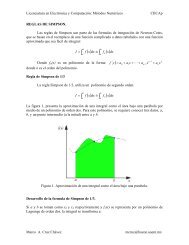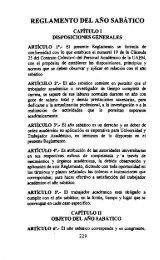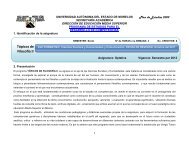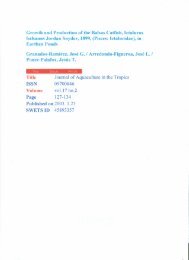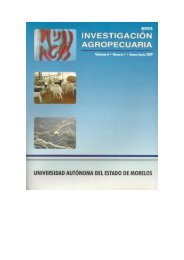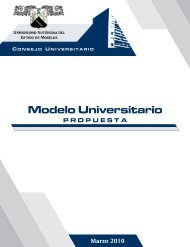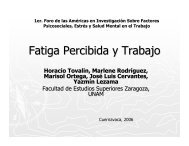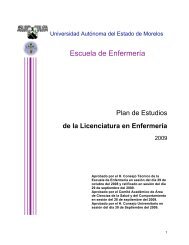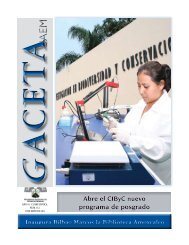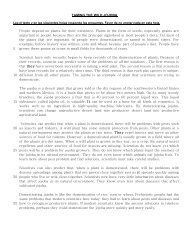Descargar - UAEM - Universidad Autónoma del Estado de Morelos
Descargar - UAEM - Universidad Autónoma del Estado de Morelos
Descargar - UAEM - Universidad Autónoma del Estado de Morelos
Create successful ePaper yourself
Turn your PDF publications into a flip-book with our unique Google optimized e-Paper software.
Investigación Agropecuaria. 2010. Volumen 7(1). p. 87-99.<br />
_________________________________________________________________________________________________________<br />
ABSTRACT<br />
The objective of the study was to<br />
generate information concerning to milk<br />
innocuousness. Direct observation and<br />
structured interviews were applied to<br />
technician counsellors and producers<br />
selected at random in or<strong>de</strong>r to get a sample<br />
of the size of 19, <strong>de</strong>termined through the<br />
technique of Stratified Aleatory Sample. The<br />
issues that were recor<strong>de</strong>d were: the general<br />
conditions of production, the sanitary<br />
handling of the herd, of the procedures<br />
during the milking and the handling of the<br />
milk after the milking procedure. Samplers<br />
of milk were analyzed in the laboratory. It<br />
was found out that 66.6 % of them carry out<br />
diagnostic tests of tuberculosis and<br />
brucellosis; 83 % check mastitis. Also the<br />
milking is carried out, in the 95 % of the<br />
cases, in spaces where fauna can enter<br />
freely; 47 % wash the teats with water and<br />
dry them up with a piece of clothe, 21 %<br />
clean them up with a piece of clothe only;<br />
7.5 % do not clean at all; 44 % seal the<br />
nipples. The water they use is from; a<br />
communitarian water system in the 42 % of<br />
the cases, 37 % from natural sources, 16 %<br />
from rain or channels and 5 % do not use it.<br />
Concerning to commercialization, it was<br />
found out that the 79 % of the cattle<br />
bree<strong>de</strong>rs make some sort of milky <strong>de</strong>rived<br />
products. Laboratory results show absence<br />
of brucellosis, tuberculosis and mastitis,<br />
nevertheless the data obtained for the Total<br />
Bacterial Count, Counting of Coliformes<br />
Bacterias and presence of Bacterial<br />
Inhibiters point out the necessity of<br />
improving and handling of milk. The<br />
production, commercialization of raw milk<br />
and manufacturing of handicraft milky<br />
products is a rural reality that must be<br />
atten<strong>de</strong>d.<br />
Key words: hygiene, conditions of<br />
production, procedures, innocuousness.<br />
88<br />
INTRODUCCIÓN<br />
Internacionalmente, han cobrado<br />
impulso las reformas a las regulaciones<br />
para asegurar la inocuidad <strong>de</strong> los alimentos,<br />
sobre todo por la aparición <strong>de</strong><br />
enfermeda<strong>de</strong>s <strong>de</strong>rivadas <strong>de</strong> los alimentos,<br />
tales como “el mal <strong>de</strong> las vacas locas”, E.<br />
Coli, salmonelosis, Campylobacter y<br />
Listeria, (Solleiro, 2003) México no es la<br />
excepción y ha emitido leyes, reglamentos y<br />
Normas Oficiales en relación con ello,<br />
mismas que aplican bajo cualquier<br />
circunstancia. Se requiere abordar en el<br />
conocimiento <strong>de</strong> la inocuidad en la<br />
producción láctea, aplicando la higiene <strong>de</strong><br />
las condiciones y los procesos <strong>de</strong><br />
producción y la inocuidad <strong>de</strong> los productos.<br />
A la fecha, diversos trabajos referidos a la<br />
inocuidad <strong>de</strong> la leche, concluyen que la<br />
leche <strong>de</strong> esos sistemas cumple con las<br />
características físico - químicas que<br />
establece la normatividad correspondiente;<br />
no así con las <strong>de</strong> inocuidad (Bernal et al,.<br />
2003; Vázquez et al., 2005).<br />
Es necesario i<strong>de</strong>ntificar alternativas<br />
para la producción <strong>de</strong> alimentos sanos para<br />
los consumidores, ya que el 50% <strong>de</strong> la<br />
comercialización <strong>de</strong> leche cruda en zonas<br />
rurales y en los sistemas <strong>de</strong> producción <strong>de</strong><br />
lechería familiar y <strong>de</strong> doble propósito, se<br />
hace por medios informales, en los que no<br />
hay controles sanitarios ni <strong>de</strong> precio<br />
(García, 1996; Aguilar et al., 2001).<br />
Así, la comercialización <strong>de</strong> leche<br />
bronca directamente al consumidor es una<br />
opción para los sistemas <strong>de</strong> producción <strong>de</strong><br />
lechería familiar y <strong>de</strong> doble propósito,<br />
(García, 1996; Aguilar et al., 2001) y por lo<br />
tanto cabe esperar la permanencia <strong>de</strong> tal<br />
alternativa productiva y aún su incremento;<br />
sin embargo, <strong>de</strong>be reconocerse el riesgo en<br />
materia <strong>de</strong> inocuidad.<br />
Con el propósito <strong>de</strong> contribuir al<br />
conocimiento <strong>de</strong> este fenómeno, en el<br />
período <strong>de</strong> los años 2005 a 2006 se llevó a<br />
cabo el presente estudio que integra la



